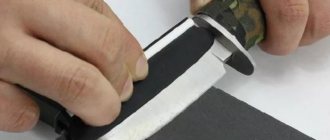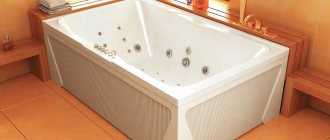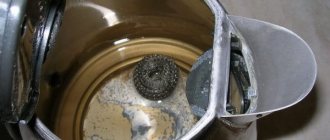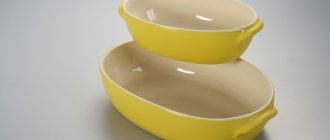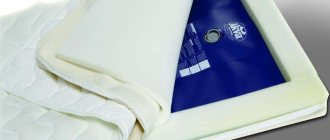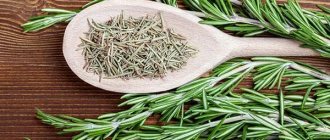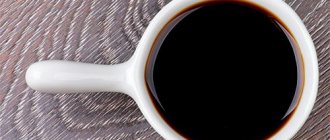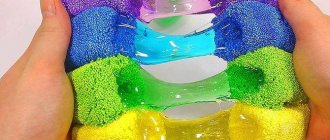Musat is a sharpening tool that is used both by professionals and at home. With its help, you can sharpen knives, straighten blades, and can be used daily without damaging the metal of the cutting tool. There are diamond, ceramic and steel musats; each type has individual advantages and some disadvantages.
The cost of musats ranges from 100-5000 thousand rubles; ceramic ones are considered the most expensive. You can make a tool yourself (from an electrode), but experts say that this is not advisable - the sharpening quality is low and the service life is short.
What is musat, what is it for?
Musat is a special device that is used for straightening knives; it is needed to keep the edge of the blade always sharp. It is an imitation of a round file with a handle. The main feature of musat is that when editing a knife, shavings are not removed from the metal, the surface of the blade remains unchanged, which extends the life of the cutting tool. It is important that the hardness of the metal of the sharpening tool exceeds that of the knife.
Knife musats, depending on the area of use, are divided into three large groups:
| Household | These are the cheapest tools, having a length of only 180-230 mm. Used for sharpening ordinary kitchen knives, which have a “soft” blade metal. |
| Universal | Much better in quality and more expensive than household ones, they have a “rod” length of 260-290 mm. Excellent for working with hard blades. |
| Professional | Their main difference is their size: the length of the “rod” is 260-360 mm. If you need to prepare a knife for cutting meat, then you should use thin musat, the length of which is 320-360 mm. Professional chefs prefer a tool with a thicker “rod” (260 mm). |
Types of musat for knives by material
When buying polish for knives, you should pay attention to the material from which it is made:
- ceramics;
- metal;
- diamond.
Depending on this parameter, the sharpening tool is used to work with different types of knives.
Ceramic
This kind of knife polish has a ceramic coating of different abrasiveness on the “rod” - on one side there are notches on the surface, on the other it is absolutely smooth. The first option is necessary for sharpening the blade, to give a sharp edge to the blade. But a smooth ceramic coating will be needed for finishing straightening the metal.
Ceramic musat is optimally suited for working with knives of low metal hardness. It should also be used for straightening wide blades and old, “worn out” cutting tools.
Ceramic musat
Diamond
Diamond musat is recognized as the best sharpening tool, because just a few movements are enough and even the hardest/largest knife will become sharp again. A tool with a diamond “rod” is not used for sharpening the blade; it can only be used to straighten and polish the metal.
Diamond musat is made from chrome-plated steel, with diamond particles sprayed on top. The tool is produced in an oval shape, which prevents the formation of nicks on the surface.
It is important to properly care for this type of musat:
- Be sure to rinse by hand under running water after use;
- dry naturally (do not wipe with a towel);
- Store separately from any solid objects.
Diamond musat
Steel, metal
Steel nuts are made from an alloy of chromium and vanadium; the main advantage of a metal tool is the maximum hardness of the “rod”. The surface is smooth, the tool is necessary for straightening and polishing the blade, but is never used as a sharpening device.
There are no special features in caring for metal musat; it is quite simple to keep it clean.
Fischer Éco round steel nut, chrome plated
Mixed
A mixed sharpening tool is one that has different surfaces: one smooth, the other with fine serrations. This musat can be used to sharpen, sharpen, and polish knives.
Musaty
good topic with musats, a necessary topic.
I’m not a great expert on sharpening in general, and especially on musats.
and I practically never go to the sharpening branch of the Hansa - they are terribly far from the people, everything there is too academic, not for my weak mind.
Therefore, I will express my opinion, but, probably, this was written many times without me.
a few points from the manufacturer’s point of view:
1. Most knife users are armless pigs who do not know how (this is fixable) and do not want to be able (this is almost impossible to treat) to use the tool so that it serves for a long time, faithfully and with consistently excellent results.
and the further the world slides along the path of ersatz goods and ersatz people and the uncontrollable consumption of everything through all the holes, the worse this process goes.
2. There are few craftsmen, but there are plenty of buy-and-sell manufacturers.
The common interests here are that the average pig should, at a minimum, not receive negative emotions when using the products, and it is better that she likes the company’s products.
The master is interested in ensuring that his expensive, cleverly made knife is not ruined and that a year later he raises a cry to the whole world that they sold him crap.
because here the information is different, the processing materials and sharpening devices are different, and the educational program is readable.
The manufacturer is interested in the following:
2.1 produce goods of acceptable quality at the cheapest possible cost.
Therefore, the materials are cheap, processing is cheap, labor is easily replaceable.
2.2. To provide some kind of pleasure from using the instrument of that very average pig, and preferably, to get quite a lot of money at the same time.
2.3 Ensure a good product life, but the shortest possible “scabies period”
If in Russian, then you should be able to use a knife for a long time (we look at how well we do it), but the consumer should want to buy something new as quickly as possible.
3. thinking that demand creates supply, it is almost not true.
Demand is formed, and then it creates supply.
In life, this means that the user does not buy what he wants, but they sell him what he was taught to want to buy.
Naturally, the average burgher should not know this, but should smugly think that it was he, such a significant and central one, who wanted to buy shitsteel musat for a hundred bucksoff.
Otherwise, people would have long ago been sharpening in mass on a piece of skin, which is an order of magnitude cheaper than stone, much lighter and often gives better results than mass-produced stones
It is clear that this does not apply to everyone, but only to those who are too lazy to use their heads and give themselves the trouble to understand this issue as well.
But for the most part this is how it is, in my humble opinion.
This is not that bad, standard imposed consumption, but not good.
What is bad for a knowledgeable person is that production and commerce are designed for mass demand, so you will have to look for something that will satisfy the perceived high demands if such arise.
As for pressure, the very point of editing the geometry with musat is in a fairly high pressure applied to a point on the edge of the knife.
Actually, this is the reason why musats are not square or triangular, but round or oval.
So editing there occurs precisely by pressure, and its intensity is determined by the force of pressure.
Personally, I divide musats into three categories:
1. metal musats for classic European soft knives, that is, with a hardness somewhere up to 56-57
Why is it recommended to grind soft low-alloy knives?
Everything here is as simple as mooing.
classic kitchen = geometry = wedge from the butt or something like that
thin triangle of wedge und soft steel und sharpening frequently = soon the geometry will go wrong, the original sharpness of the wedge will simply be worn off and instead of a thin ax you will get a cleaver
soft steel and fine mixing at the rk-edge bends, that’s what turns out to be a burr
so straighten it, place it straight, and not bent to the side, and again the knife will cut for a while
That is, for such knives you don’t need a musat file, this is where you need smooth, polished musat, and this is exactly what is practically not available.
A smooth burr will lift a curved burr.
But as a rule, the manufacturer is not interested in doing such things
But most kitchen appliances, even atomic-grade German Henkels made from simple steels, do not reduce to zero, but have quite straight edges of 0.4-0.7 mm
And there is practically no longer that same burr (if sharpened normally) with which a well-knit soft knife cuts.
The knife there cuts with an edge, thus a triangle with a platform at the base of 0.4-0.7 initially, but the slopes already fall off the product and are slowed down by friction.
The knife has become dull, once, twice, three times - you can’t fool nature. The Republic of Kazakhstan becomes thicker.
This is where the notched musket comes into play, which, in addition to lifting the rolled edge, also rips the edge like a file.
The calculation here is simple - the blade and the sides of the knife are also sharpened, thereby, as it were, reshaping the angle to the rk, we essentially make the edge itself with a toothed saw.
Well, so what, it’s great, I shuffled around, and he nags aggressively until the next “edit”
These are the kind of musats that manufacturers are interested in making for their knives from cheap soft steels.
Moreover, steel can be used cheaply on musat.
There it is necessary to ensure the superiority of musat in hardness of one to three according to Rockwell, therefore, you can get by with cheap steel, and set the price quite outrageously, like for a professional thing.
- High-hard (carbide) musats of high class.
It is clear that such a device can be used both for soft European-type knives and for not so hard Japanese stainless steel ones.
Again, it is clear that there is not much point in making it a file; cheaper musats will cope with this role.
Such musats should be smooth.
- Ceramic musats.
It is absolutely clear that, as a rule, this is a complex tool.
Ceramics, due to its amazing hardness, quite successfully copes with the role of a classic smooth musat, straightening a cutting edge bent to the side.
But also, to one degree or another, due to the abrasiveness of the surface, it ensures sharpening of the edge, gently removing metal.
It is clear that the intensity of metal removal is very different and depends on whether the metal is smooth or with ribs, and if it is smooth, then how smooth its surface is.
Most ceramic musats are still files, but their production is profitable - cheap raw materials, cheap production, and the selling price is high and most people are happy to cut a knife quite cheerfully after such a musat.
Personally, I am in favor of smooth ceramic tools with little metal removal, although here you can actually make a universal tool.
Half is round or oval, and half is flat, and the aggressiveness of the surface can be varied.
By the way, musat can also be polished, so if desired, the aggressiveness of smooth musat can be corrected.
But even solid Japanese ones can edit/sharpen such musats - quickly, conveniently, efficiently.
That's all in a nutshell.
I'll edit tomorrow, I want to sleep
What types of musats are there for sharpening knives by function?
Musats are used not only for sharpening knives, but also for polishing them. Moreover, the industry produces two types of tools, which differ in their functional “accessories”.
For grinding
Grinding musk can be:
- tubular;
- round;
- flat.
Forms of musats
The tool is used even for new knives, because the edge of the blade is not brought to perfection in production. Grinding musat is optimal for straightening kitchen knives whose sharpness level has simply decreased a little. It is impossible to fully sharpen a cutting tool with this type of device.
For initial sharpening
The most popular musats are those that are made of metal and have notches on their surface. The shape of the tool can be absolutely any, it is chosen individually - who is comfortable working with what.
For initial sharpening of knives, it is best to use a classic round steel grinder, the length of which ranges from 250-300 mm. It must be taken into account that this parameter should always be 50 mm greater than the length of the blade of the knife that needs to be sharpened.
Watch the video on how to sharpen a knife using musat:
Editing the knife
To edit a knife, you will need a sharpener that rests on a convenient surface. In this case, the device not only sharpens the tip, but also straightens the blade. It is not difficult to perform the procedure correctly; you do not need to have special knowledge and skills. There are several rules that will help you edit your knife:
- The musat must be installed exactly as when sharpening, that is, on a non-slip surface. To do this, you can use a cutting board, napkin or towel.
- The tool should be tilted to the right by 20-25 degrees.
- The tip must be applied to the beginning of the musat rod on the right side and move down.
- Having tilted the musat to the right, you need to do the same procedure, but on the other side of the blade.
All actions must be repeated until the knife acquires the desired sharpness.
How to sharpen knives with musat on weight
Sharpening a knife with musat while hanging is carried out according to the following algorithm:
- Take a knife in your hand and place its blade downwards at the bottom of the musat. The cutting edge at this moment should be in the “away” position.
- The blade moves towards itself along the surface of the tool. It is important to maintain the angle of inclination.
- Several repetitions of the movements are performed - quickly, but without pressure.
- Turn the knife over with the blade facing you and repeat the process.
It’s not easy to sharpen knives while hanging with musat, but this is exactly how professional chefs use the tool. For the process to proceed correctly, three rules must be followed:
- The angle of inclination of the musat in relation to the knife blade should be strictly 20 degrees.
- Back-and-forth movements are performed at a fast pace.
- Jerking and too sharp “jerks” are strictly not allowed.
This method of sharpening knives is considered dangerous because there is a high probability of the blade jumping off the surface of the grinder and injuring the hands, even the stomach. To make the cutting tool sharp, it is enough to repeat the movements 5-6 times for each side of the blade. If the knife is very dull, then the number of repetitions increases by one and a half to two times.
You can also sharpen a completely new knife while hanging, for which you can maintain an angle of inclination of the grinder of 30 degrees. In this case, the movements of the blade are performed with light pressure and in the direction “away from you.”
How to use with support
It is much easier to use a grinder with a support; the sharpening process in this case will proceed in a clear sequence:
- The sharpening tool rests strictly vertically on a hard surface. To prevent it from slipping, it is recommended to place a towel.
- Already at the stop you need to position the tool at an angle of 20-25 degrees.
- The knife blade moves along the surface of the musat strictly perpendicularly.
- They begin the movement from the top - the base of the knife is adjacent to the sharpening tool, and end at the bottom - the tip of the blade is adjacent to the sharpening tool.
It is important to make movements only in one direction - from top to bottom; to repeat, the knife blade comes off the surface of the “rod”.
How to edit a knife
You can and should sharpen knives with musat every day so that the blade always remains sharp. The process is performed according to the same algorithm as sharpening a tool with a support, but with one difference - the tip of the knife is applied to the right to the upper part of the “rod”. Next, a downward movement is made and repeated 4-5 times for each side.
You can simplify the process and position the sharpening tool not vertically, but horizontally, slightly lifting it above the surface by the handle. After finishing work on editing the knife, be sure to wipe its blade from metal chips.
Watch the video on how to sharpen a knife with musat:
How can you tell if a knife is sharp enough?
After sharpening, you must check whether the blade is sharpened well. To do this, you can use one of these methods:
- Select a strand of hair at the back of your head and press the knife against it at a right angle. Swipe through hair from top to bottom without making sudden movements. If the blade is still dull, it will slip off easily, whereas a sharpened point will stick.
- Take a newspaper or sheet of paper and hold it suspended. In this position, try cutting the sheets: if you succeed, the sharpened knife is already quite sharp.
For many cooks, musat has become an indispensable item in the kitchen. This is due to the fact that it is easy to use, it does not damage knife blades and lasts a very long time if used correctly.
Related article: DIY ribbon butterfly for a boy in kanzashi style
How to choose musat for sharpening knives
You should choose musat for sharpening knives according to the clear recommendations of experts:
- if the coating of the “rod” is diamond, then no dust or small crumbs should fall off it - just rub it with your finger to ensure the quality of the tool;
- ceramic musat should not have visible damage - scratches, chips;
- High-quality steel models are distinguished by uniform metal density - there should be no roughness on the surface of the “rod”.
It is highly desirable that a magnet be “built-in” at the tip of the sharpening tool. This improvement of the grinding cloth ensures the collection of metal dust during sharpening or straightening of knives.
Which is better - ceramic or steel?
It is believed that between ceramic and steel musat it is better to choose the first option:
- ceramic coating is durable;
- working with knives does not damage the metal.
But steel musat also has an important advantage - it is resistant to falls and impacts, while ceramics are damaged very easily.
Which professional do you choose?
Professional grinders are distinguished by their size - the length of the entire tool does not exceed 260 mm. Chefs claim that the surface of the “rod” should be polished as much as possible in order to see one’s own reflection in it. This means that you should pay attention to metal and steel sharpening tools.
If the choice is made to use musat in a regular kitchen, then it will be especially convenient with a thin rod, because it will be easy for them to sharpen both narrow and wide knives of different shapes.
Recommendations for selection
To select a quality tool, you must follow the following rules.
- Choose a model in which you can see your own reflection. Professional chefs are guided by this indicator.
- The magnet on the tip of the musat increases the level of comfort of its use. After all, this way you can effortlessly remove dust from the knife.
- To protect your fingers from possible damage, choose models with a guard between the handle and the rod.
- As for materials, pay special attention to ceramics, since such a tool is characterized by durability and excellent sharpening properties without harming the steel of the knife.
We suggest you read How to clean a wool cap at home
- Follow the rules for storing tools. If, for example, a diamond tool is stored together with knives and other hard objects, it will quickly become dull.
Before choosing a musat, carefully check the quality of the product and its rating in relation to other models. A good diamond tool will not lose its coating. Ceramic models have no visible mechanical damage. The density of the steel model is uniform, without roughness. And only if these indicators are observed, it is possible to buy the best musat offered by the market.
How to properly care for a musat knife
The musat knife can be actively used for a long time, but for this you need to properly care for it:
- after use, the tool should be stored suspended - on a hook or in a special stand;
- You need to wash the musat with warm water, any detergent, but without abrasive particles in the composition;
- if the “rod” is diamond coated, then the tool should be stored separately from any other hard objects;
- Ceramic tools should not be dropped or knocked - even a small chip or shallow scratch makes it impossible to use the tool for its intended purpose.
The tool must be stored in a special stand
How to make musat from an electrode
If you wish, you can make this sharpening tool from an electrode with your own hands; to do this, you will need to follow the steps in the following order:
- Prepare a surfacing electrode, the most suitable ones will be from . Cut it to the required length (within 180-200 mm).
- Remove the top layer from the surface of the rod with a whetstone. It is worth using such a tool with a fine abrasive surface.
- A handle must be attached to one end of the electrode. It can be made of wood or plastic; in the latter case, it is recommended to use a ready-made screwdriver or any other suitable tool.
Homemade musat from an electrode is ineffective; it is suitable only for straightening kitchen knives, and this process will need to be carried out almost every day.
We recommend reading the article about types of knives. From it you will learn about the main types, shapes of knives, their names and characteristics, knife blade materials by type of metal, as well as the rules and selection criteria. And here is more information about knife stands.
Musats are used by both professional chefs and housewives. They are convenient for sharpening/sharpening any knives, you just need to make the right choice of tool. They have a long service life provided proper care and storage.
Useful video
Watch the video on how to make musat yourself:
Similar articles
- Whetstone: which one is better to choose based on grain size...
What is a whetstone, whetstone. How to choose the right one for kitchen knives, the best by manufacturer. What main parameters need to be taken into account - grain size, size, composition. What do water-based, oil-based, ceramic, abrasive stones mean? How to properly care for a sharpener. Is it possible to make it yourself and from what? Read more - Hunting knives: main and best types, sizes, how...
What are the best hunting knives for both professionals and beginners? What are the parameters of knives for hunting: sizes, sheaths, steel, shape. How to choose a knife, make it yourself. How much does a knife cost, how to buy a good one for hunting, fishing and tourism. Read more
- Knife stand: how to make it yourself...
What types of knife stands are there, is it different for kitchen, decorative, and souvenir ones. How you can make a knife stand with your own hands from plywood, with filler, decoupage according to the drawings. What are the differences between a shelf, stand, glass, brush stand, holder, their pros and cons. Read more
- Switchblade: main types - American, Soviet...
What kind of switchblade is there? What are the most popular types among Russian, Soviet, American manufacturers. Some knives with a secret, some frontal, push-button. Is it a melee weapon or not? What are the advantages of an automatic switchblade. Read more
- Knife handle: depending on size, thickness, how...
What kind of knife handle can be based on the main indicators - thickness, size, method of decoration. How to make a handle for a knife, which drawing is suitable. How to attach a blade to a handle. Is there a knife without a handle? Read more
